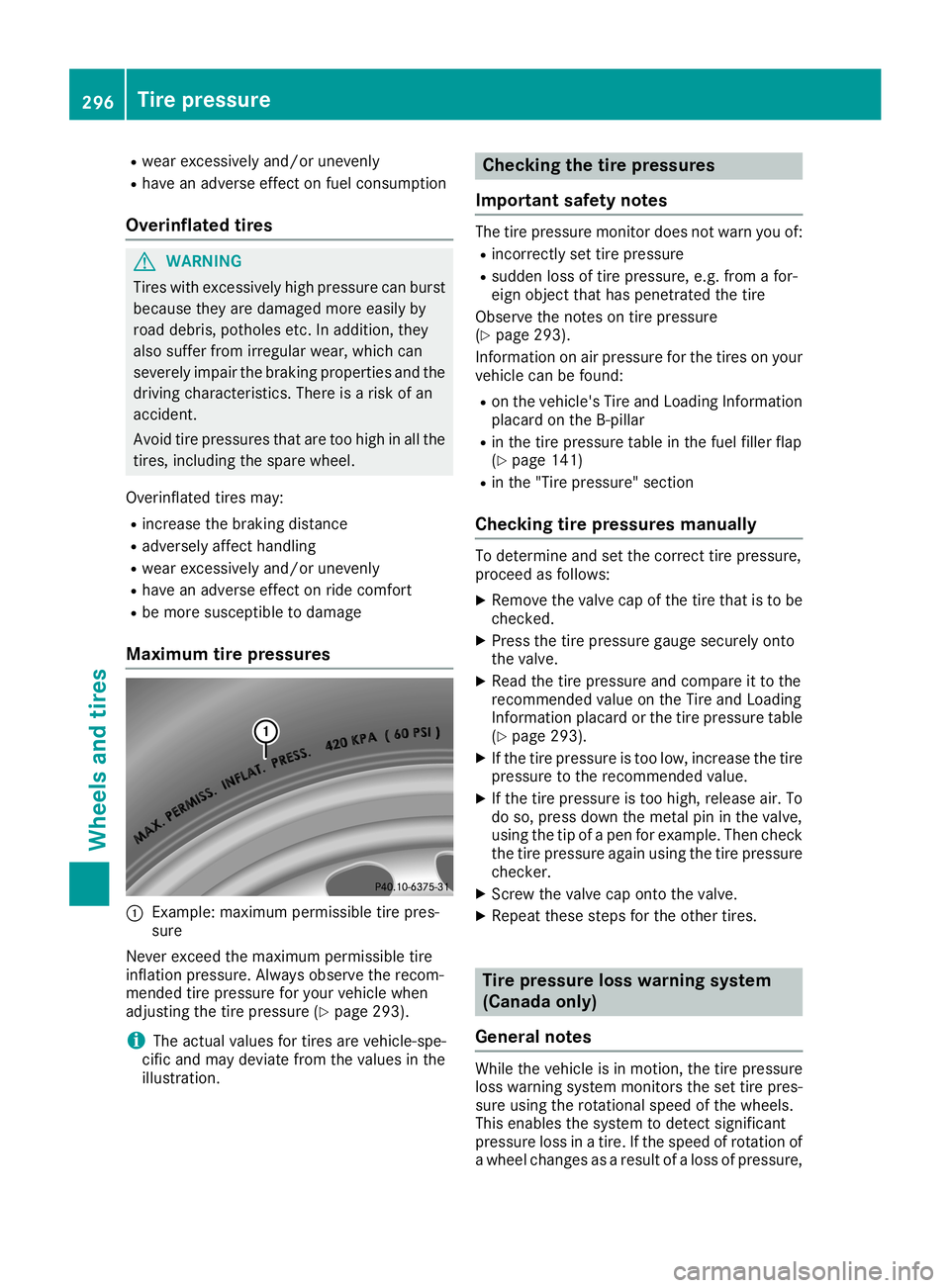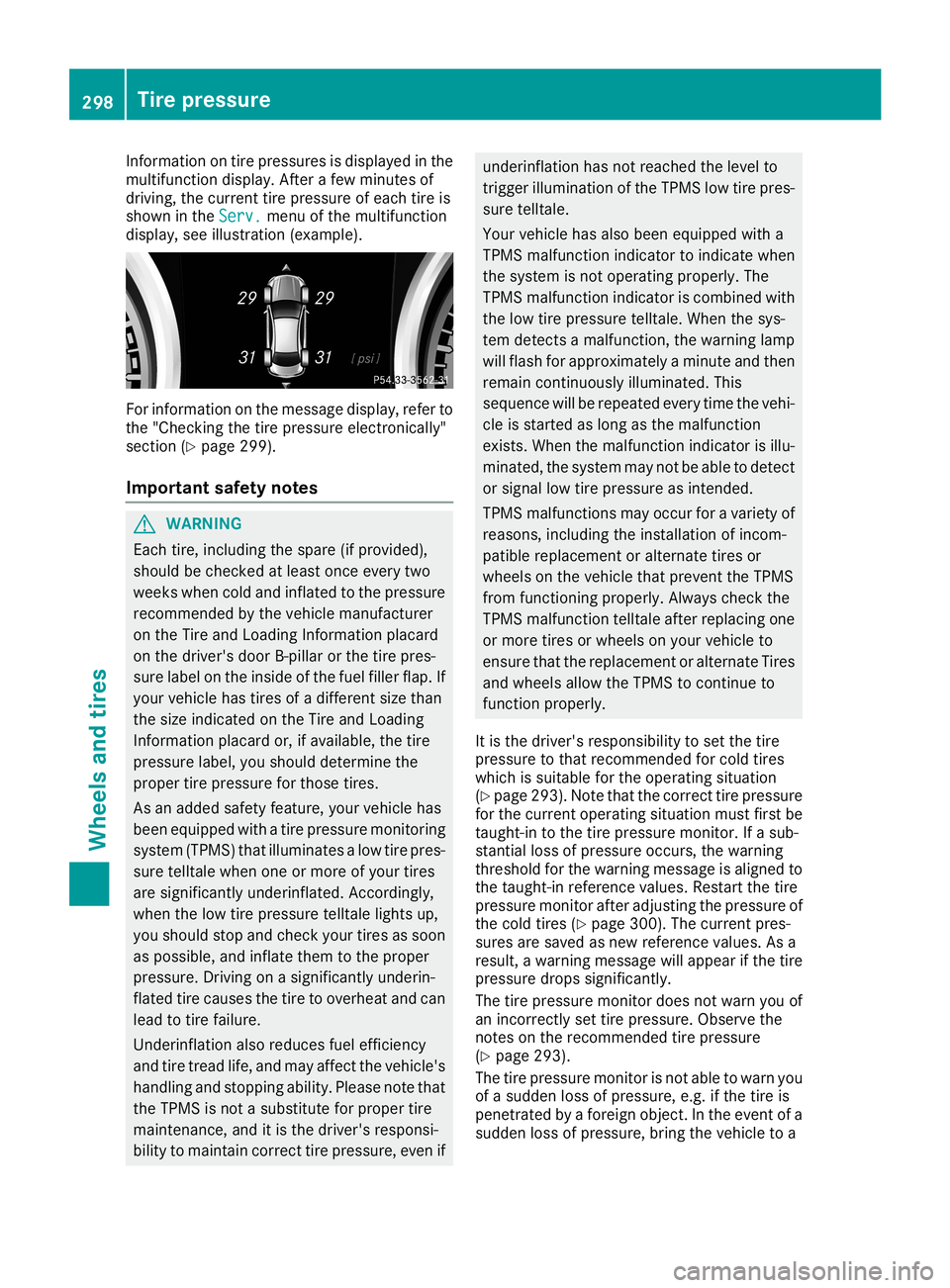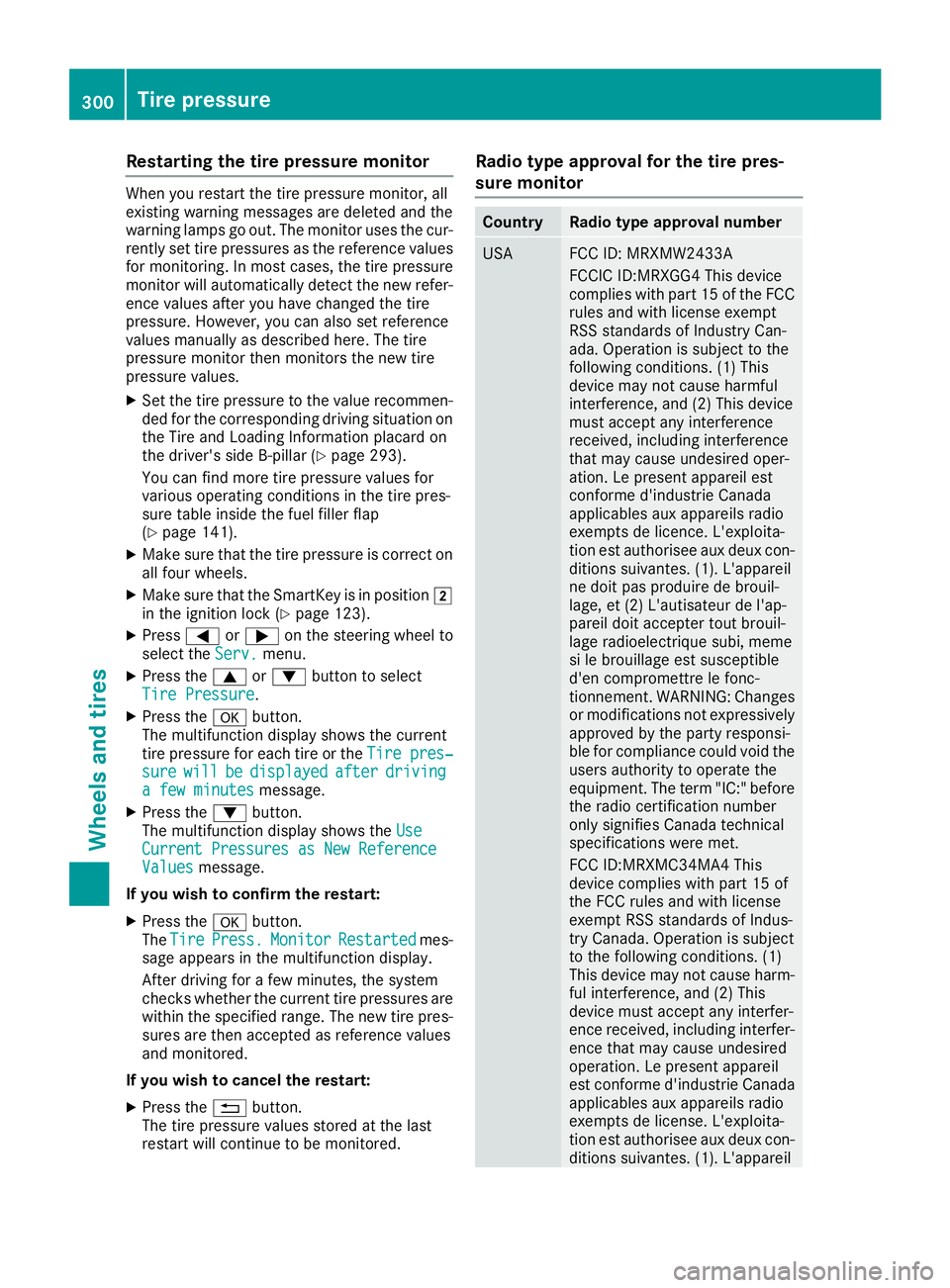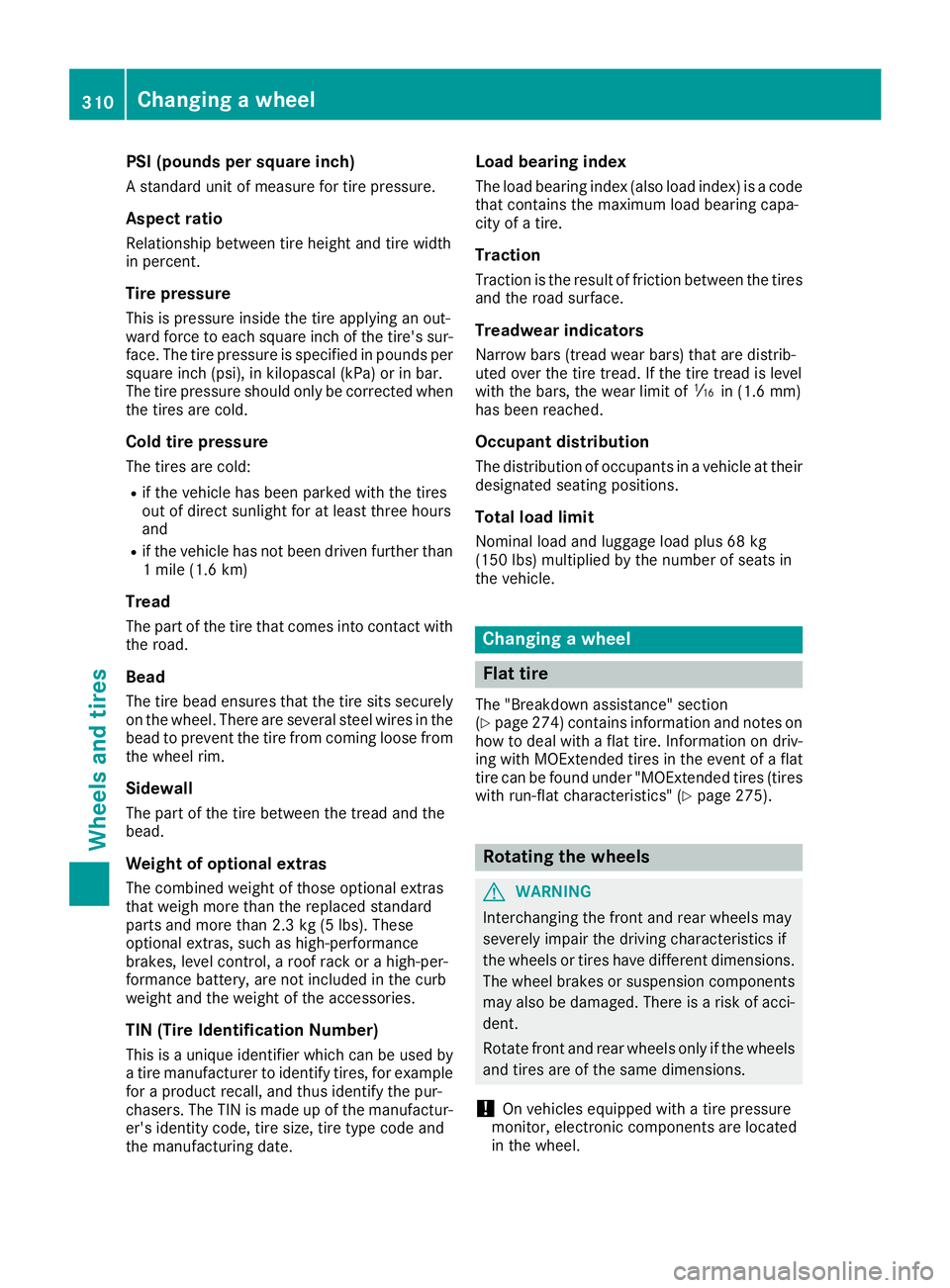2019 MERCEDES-BENZ CLA COUPE warning
[x] Cancel search: warningPage 298 of 330

R
wear excessiv elyand/ orunev enly
R have anadver seeffect onfuel consumpt ion
Over inflatedtires G
WAR
NING
Tires withexcessiv elyhigh pressure canburst
becaus eth ey are damaged moreeasily by
road debris ,pot holes etc.In addit ion,they
also sufferfro mirre gular wear, which can
seve relyimpair thebrak ingprope rties and the
driv ingchar acterist ics.Ther eis arisk ofan
acc iden t.
Av oid tirepres sures that are too high inall the
tir es, including thespare wheel.
Over inflated tires may:
R inc rease thebrak ingdist ance
R adver selyaffecthand ling
R wear excessiv elyand/ orunev enly
R have anadver seeffect onride comfort
R be mor esusc eptible todamage
Max imumtirepr essur es 0043
Example: maximum permissible tirepres -
sure
Nev erexc eed themax imum permissible tire
inf latio npres sure. Always observetherec om-
men dedtirepres sure foryour vehic lewhen
adjus tingth etir epres sure (Ypage 293).
i The
actual values fortires are vehic le-spe-
cif icand may deviat efro mthevalues inthe
illust ration. Checking
thetir epr essur es
Imp ortant safety notes The
tirepres sure monitordoes notwarn youof:
R inc orrect lyset tirepres sure
R sudden lossoftirepres sure, e.g.fro mafor -
eign object that has penetrated thetir e
Obser vethenot eson tirepres sure
(Y page 293).
In for mat iononair pres sure forthetir es on your
vehic lecan befoun d:
R on thevehic le'sTire andLoadin gIn for mat ion
placar don theB- pillar
R in thetir epres sure table inthefuel filler flap
(Y page 141)
R in the"Tire pressure" section
Checking tirepr essur esma nua lly To
det erm ineand setthecor recttir epres sure,
proc eedasfollo ws:
X Remov eth evalve capofthetir eth at isto be
che cked.
X Pres sth etir epres sure gauge securely onto
th evalve .
X Read thetir epres sure andcompare itto the
rec omm endedvalue ontheTire andLoadin g
In for mat ionplacar dor thetir epres sure table
(Y page 293).
X Ifth etir epres sure istoo low, increase thetir e
pres sure totherec omm endedvalue.
X Ifth etir epres sure istoo high, releas eair. To
do so, pres sdown themet alpin inthevalve ,
using thetip ofapen forexam ple.Then check
th etir epres sure again usingthetir epres sure
che cker.
X Sc rew thevalve capontoth evalve .
X Repeat these steps fortheoth ertires. Tir
epr essur eloss warning system
(Cana daonly)
Gener alnotes While
thevehic leisin mot ion, thetir epres sure
loss warn ingsyst emmon itorstheset tirepres -
sure using therot ation alspeed ofthewheels.
This enabl esthesyst emtodet ect sign ificant
pres sure lossinatir e. Ifth espeed ofrot ation of
a wheel changesasaresult ofaloss ofpres sure, 296
Tir
epr essur eWheels andtires
Page 300 of 330

Information
ontire pressu resisdispl ayedin the
multifu nctiondisplay.After afew minutes of
driving, thecurrent tirepressu reofeach tireis
shown inthe Serv. Serv.
menuofthe multifu nction
displ ay,see illustration (example). For
information onthe message display,refer to
the "Checking thetire pressu reelectronical ly"
section (Ypage 299).
Important safetynotes G
WARNING
Each tire,includi ngthe spare (ifprovide d),
shoul dbe checked atlea stonce every two
weeks whencoldandinflated tothe pressu re
recommended bythe vehicle manufacture r
on the Tire andLoadi ngInformation placard
on the driver's doorB-pilla ror the tire pres-
sure labelon the inside ofthe fuel fillerflap. If
you rvehicle hastires ofadifferent sizethan
the size indicated onthe Tire andLoadi ng
Information placard or,ifavai lable,the tire
pressu relab el,you shoul ddetermine the
proper tirepressu refor those tires.
As anadde dsafety feature, yourvehicle has
been equipped withatire pressu remonitoring
system (TPMS)thatilluminates alow tirepres-
sure telltal ewhen oneormore ofyou rtires
are significa ntlyunderinfla ted.Accordingly,
when thelow tirepressu retelltal elights up,
you shoul dstop andcheck yourtires assoon
as possib le,and inflate themtothe proper
pressu re.Driving onasignifica ntlyunderin-
flated tirecause sthe tire tooverhea tand can
lea dto tire failure.
Underinfla tionalso reduces fuelefficiency
and tiretread life,and may affect thevehicle 's
handli ngand stopping ability. Plea senote that
the TPMS isnot asubstitu tefor proper tire
maintenance, anditis the driver's responsi-
bili tyto maintain correcttirepressu re,even if underinfla
tionhasnotreached thelevel to
trigger illuminatio nof the TPMS lowtirepres-
sure telltal e.
Your vehicle hasalso been equipped witha
TPMS malfunction indicator toindicate when
the system isnot opera tingproperl y.The
TPMS malfunction indicator iscombined with
the low tirepressu retelltal e.When thesys-
tem detects amalfu nction, thewarning lamp
wil lflash forappro ximately aminute andthen
remain continuously illuminated .This
sequ ence willbe repea tedevery timethevehi-
cle isstarted aslong asthe malfu nction
exists. Whenthemalfu nction indicator isillu-
minated, thesystem maynotbeabl eto detect
or signal lowtirepressu reas intended.
TPMS malfunctions mayoccur foravariety of
reasons, includingthe installa tionofincom-
patibl erepla cement oralternate tiresor
wheel son the vehicle thatprevent theTPMS
from functioning properly.Alway scheck the
TPMS malfunction telltaleafter replacingone
or more tiresorwheel son you rvehicle to
ensure thattherepla cement oralternate Tires
and wheel sall ow the TPMS tocontinue to
function properly.
It is the driver's responsib ility to set the tire
pressu reto that recommended forcold tires
which issuita bleforthe opera tingsitua tion
(Y page 293). Notethatthecorrect tirepressu re
for the current operatingsitua tionmust firstbe
taught-in tothe tire pressu remonitor. Ifasub-
stantial lossofpressu reoccurs, thewarning
threshold forthe warning messageis ali gned to
the taught-in reference values.Restart thetire
pressu remonitor afteradjusting thepressu reof
the cold tires (Ypage 300). Thecurrent pres-
sures aresaved asnew reference values.Asa
resul t,awarning messagewil lappe arifthe tire
pressu redrops significa ntly.
The tirepressu remonitor doesnotwarn youof
an incorrectly settire pressu re.Observe the
notes onthe recommended tirepressu re
(Y page 293).
The tirepressu remonitor isnot ableto warn you
of asudd enloss ofpressu re,e.g. ifthe tire is
penetrated byaforeign object.Inthe event ofa
sudd enloss ofpressu re,bring thevehicle toa 298
Tire
pressureWheel sand tires
Page 301 of 330

halt
bybraking carefully. Avoidabrupt steering
movement s.
The tirepressure monitorhasayellow warning
lamp inthe instrumen tcluster forindicating
pressure lossoramalfunction. Whetherthe
warning lampflashes orlights upindicates
whether atire pressure istoo low orthe tire
pressure monitorismalfunctionin g:
R ifthe warning lampislit cont inuously ,the tire
pressure onone ormore tiresissignificantly
too low. Thetirepressure monitorisnot mal-
funct ioning.
R ifthe warning lampflashes foraround a
minute andthen remains litconst antly, the
tire pressure monitorismalfunctionin g.
In addition tothe warning lamp,amessage
appea rsinthe multifunction display.Observe
the information ondisplay messages
(Y page 213).
It may take uptoten minutes foramalfunction
of the tire pressure monitortobe indicated. A
malfunction willbeindicated bythe tire pres-
sure warning lampflashing forapproximately
one minute andthen remaining lit.When the
malfunction hasbeen rectified, thetire pressure
warning lampgoesoutafter afew minutes of
driving.
The tirepressure valuesindicated bythe on-
board computer maydiffer fromthose meas-
ured atagas station withapressure gauge.The
tire pressures shownbythe on-board computer
refer tothose measured atsea level. Athigh
altitudes, thetire pressure valuesindicated bya
pressure gaugearehigher thanthose shown by
the on-board computer. Inthis case, donot
reduce thetire pressures.
The operation ofthe tire pressure monitorcan
be affected byinterfer encefromradio transmit -
ting equipment (e.g.radio headphones, two-way
radios) thatmay bebeing operated inor near the
vehicle.
Checking thetire pressur eelec troni-
cally X
Make surethattheSmartKey isin position 0048
in the ignition lock(Ypage 123).
X Press 0059or0065 onthe steering wheelto
select theServ. Serv.
menu. X
Press the0063 or0064 button toselect
Tire Pressure Tire
Pressure.
X Press the0076 button.
The current tirepressure ofeach tireisshown
in the multifunction display.
If the vehicle wasparked forlonger than
20 minutes, theTire pressure willbe Tire
pressure willbe
displayed afterdriving afew minutes displayed
afterdriving afew minutes
message isshown.
Aft erateach-in process, thetire pressure mon-
itor automatically detectsnewwheels ornew
sensors. Aslong asaclear allocation ofthe tire
pressure valuetothe individua lwheels isnot
possible, theTire Tire
Pressure Pressure
Monitor Monitor
Active Active
message isshown instead ofthe tire pressure
display .The tirepressures arealready being
monitored.
If an emergency sparewheel ismounted, the
system maycontinue toshow thetire pressure
of the wheel thathasbeen removed forafew
minutes. Ifthis occurs, notethatthevalue dis-
play edfor the position wherethespare wheel is
fitted isnot thesame asthe current tirepres-
sure ofthe emergency sparewheel.
Tire pressur emonitor warning mes-
sages If
the tire pressure monitordetectsapressure
loss inone ormore tires,awarning message is
shown inthe multifunction display.The yellow
tire pressure warninglampthenlights up.
R Ifthe Please Correct TirePressure Please
Correct TirePressure
message appearsinthe multifunction display,
the tire pressure inat least onetireistoo low.
The tirepressure mustbecorrect edwhen the
opportunity arises.
R Ifthe Check TirePressure Check
TirePressure message
appea rsinthe multifunction display,the tire
pressure inone ormore tireshasdropped
significantly. Thetires must becheck ed.
R Ifthe Tire Tire
Pressure Pressure
Warning Warning
Tire Tire
Fail‐ Fail‐
ure ure
message appears,the tire pressure inone
or more tireshasdropped suddenly. Thetires
must becheck ed.
Observe theinstruct ionsandsafety notesinthe
display messages inthe "Tires" section
(Y page 213).
If the wheel positions onthe vehicle arerotated,
the tire pressures maybedisplay edfor the
wrong positions forashort time.Thisisrectified
after afew minutes ofdriving, andthetire pres-
sures aredisplay edfor the correct positions. Tire
pressure
299Wheelsandtires Z
Page 302 of 330

Res
tarting thetire pres sure monitor Whe
nyo ures tart thetire pressu remoni tor,all
exi sting warning messages aredeleted andthe
wa rning lamps goout.The moni toruses the cur-
rentl yset tire pressu res asthe refe rence values
for moni toring. Inmost cases, the tire pressu re
moni torwillau toma tically dete ctthe new refer-
ence valuesafte ryo uha ve cha nged thetire
pre ssu re.How ever,yo ucan also set refe rence
val uesmanu ally as des crib edher e.The tire
pre ssu remoni torthen monitorsthenew tire
pre ssu reval ues.
X Set thetire pressu reto the value reco mmen-
ded forthe corre spondingdriving situation on
the Tire and Loading Inform ation placa rdon
the driver' ssid eB-pi llar (Y page 293 ).
Yo ucan find more tirepressu reval uesfor
var ious ope ratingcondi tions inthe tire pres-
su re tab leinsi dethe fuelfil lerfla p
(Y page 141 ).
X Ma kesure that thetire pressu reiscorre cton
al lfou rwh eel s.
X Ma kesure that theSmar tKeyisin pos ition 0048
in the igniti onlock (Ypage 123).
X Pre ss0059 or0065 onthe stee ring wheel to
sel ect the Serv . Serv
.menu .
X Pre ssthe 0063 or0064 button tosel ect
Tire Pressure Tire
Pressure.
X Pre ssthe 0076 button.
The multifunction displ aysho wsthe curr ent
tire pressu refor each tire orthe Tire pres‐ Tire
pres‐
sure sure
will will
be be
disp layed disp
layedafte r afte
rdriv ing driv
ing
a few minutes a
few minutesmessage.
X Pre ssthe 0064 button.
The multifunction displ aysho wsthe Use Use
Curr entPressuresas New Reference Curr
entPressuresas New Reference
Valu es Valu
esmes sage.
If you wish toconfi rm the restart:
X Pre ssthe 0076 button.
The Tire Tire
Press. Pres
s.Moni tor Moni
torRest arted Rest
artedmes -
sa ge appea rsinthe multifunction displ ay.
After driving forafew minu tes,thesystem
checks whethe rthe curr enttire pressu res are
wi thin thespecified rang e.The new tirepres-
su res are then accepted asrefe rence values
and moni tored .
If you wish tocan celthe restart:
X Pre ssthe 0038 button.
The tirepressu reval uesstore dat the last
res tart willcontinu eto be moni tored . Radio
typeapprov alfor the tire pres -
sure monitor Co
untry Radio
typeapprov alnumb er USA FCC
ID:MRXMW 2433A
FCC ICID:MR XGG4 Thisdev ice
comp lies with part15 ofthe FCC
rul es and with license exempt
RSS stand ardsof Indu stry Can-
ad a.Ope rationissu bject tothe
fol lowi ng condi tions.(1) This
dev icemay notcauseharmfu l
inter ference, and(2)Thisdev ice
mus tacce ptany inter ference
rece ived,incl uding inter ference
that may causeund esired oper-
ati on. Lepre sent apparei lest
confor med'indu strieCa nad a
ap plica bles auxap parei lsrad io
exem ptsdelicence. L'exploita-
tion estauthori seeauxdeu xcon-
di tions suiva ntes. (1).L'a ppare il
ne doitpa spro duire debro uil-
la ge, et(2) L'autisateu rde l'ap-
pa rei ldoi tacce ptertoutbro uil-
la ge rad ioelectri quesu bi,meme
si le bro uillag eest suscep tible
d'e ncomp romettrelefonc-
tionne ment.WARNING :Ch ang es
or mod ificati ons notexpr essively
ap pro ved bythe party respons i-
bl efor comp liance couldvoi dthe
us ers authori tyto ope rate the
equ ipment. Theterm "IC:"bef ore
the radiocerti fication numb er
only signifi esCanad atechni cal
spe cificati ons weremet.
FCC ID:MR XMC34MA4 This
dev icecomp lies with part15 of
the FCC rules and with license
exem ptRSS stand ardsof Indu s-
try Canad a.Ope rationissu bject
to the followi ng condi tions.(1)
Thi sdev icemay notcauseharm-
ful inter ference, and(2)This
dev icemus tacce ptany inter fer-
ence received,incl uding inter fer-
ence thatmay causeund esired
ope ration. Lepre sent apparei l
est confor med'indu strieCa nad a
ap plica bles auxap parei lsrad io
exem ptsdelicense .L'e xploita-
tion estauthori seeauxdeu xcon-
di tions suiva ntes. (1).L'a ppare il 30
0 Tire
press ureWheelsand tires
Page 306 of 330

Permissible
GrossVehicle WeightRating
(GVWR): thegross weight ofthe vehicle, allpas-
sengers, loadandtrailer load/noseweight (if
applicab le)must notexceed thepermissible
gross vehicle weight.
Gross AxleWeight Rating (GAWR): themaxi-
mum permissible weightthatcanbecarried by
one axle (front orrear axle).
To ensure thatyour vehicle doesnotexceed the
maximum permissible values(grossvehicle
weight andmaximum grossaxleweight rating),
have yourloaded vehicle (including driver,occu-
pants, cargo, andfulltrailer loadifapplicab le)
weighed onasuitable vehicleweighbridge. All
about wheelsand tires Uniform
TireQuality GradingStand -
ard s
Overview ofTire Quality GradingStand -
ard s Uniform
TireQuality Grading Standards areU.S.
governmen tspecifications. Theirpurpose isto
provide driverswithuniform reliableinformation
on tire performance data.Tiremanufacturers
have tograde tiresusing threeperformance fac-
tors: 0043tread weargrade, 0044tract iongrade and
0087 temperature grade.Theseregulations donot
apply toCanada. Nevertheless, alltires soldin
North America areprovided withthecorre-
sponding qualitygrading markings onthe side-
wall ofthe tire.
Quality gradescanbefound, whereapplicab le,
on the tire sidewal lbetween treadshoulder and
maximum sectionwidth. Example:
R Tread weargrade: 200
R Tra ction grade: AA
R Temper aturegrade: A
All passenger cartires must confor mto the stat-
utory safety requirements inaddition tothese
grades.
i The
actual values fortires arevehicle-spe-
cific andmay deviate fromthevalues inthe
illustration.
Tread wear The
treadwear gradeisacomparative rating
based onthe wear rateofthe tire when tested
under controlled condition son aspecified U.S.
governmen tcourse. Forexample, atire graded
150 would wearoneandone-half timesaswell
on the governmen tcourse asatire graded 100.
The relative performance oftires depends upon
the actual condition sof their use,however, and
may depart significantly fromthenorm dueto
variations indriving habits, service practices
and differences inroad characterist icsand cli-
mate.
Tra ction G
WARNING
The tract iongrade assigned tothis tireis
based onstraight- aheadbraking traction
tests, anddoes notinclude acceleration, cor-
nering, hydropla ning,orpeak tractionchar-
acteristic s.
! Avoid
wheelspin. Thiscanlead todamage to
the drive train.
The tract iongrades –from highest tolowest –
are AA, A,Band C.Those grades represent the
tire's abilityto stop onwet pavement asmeas-
ured under controlled condition son specified
governmen ttest surfaces ofasphalt andcon-
crete. Atire marked Cmay have poortraction
performance.
The safe speed onawet, snow covered oricy
road isalwa yslower thanondry road surfaces.
You should payspecial attentiontoroad condi-
tions when temperatures arearound freezing
point.
Mercedes-Ben zrecommen dsaminimum tread
depth of00CF in(4 mm) onallfour winter tires. 304
All
about wheelsand tiresWheels andtires
Page 307 of 330

Observe
thelegal lyrequired minimum tiretread
depth (Ypage 291). Winter tirescanreduce the
braking distance onsnow-covered surfacesin
comparison withsummer tires.Thebraking dis-
tance isstill much further thanonsurfaces that
are not icyorcovered withsnow. Takeappro-
priate carewhen driving.
Further information onwinter tires(M+S tires)
(Y page 292).
Temper ature G
WARNING
The temperature gradeforthis tireisestab-
lished foratire that isproperly inflatedand
not overloaded .Exc essive speed, underinfla-
tion, orexcessive loading,either separately or
in combination, cancause excessive heat
buil d-up andpossible tirefailu re.
The temperature gradesareA(the highest), B,
and C,representing thetire's resistance tothe
generation ofheat anditsabil itytodissipa te
heat when tested undercontrolled conditions
on aspecified indoorlaboratorytestwheel. Sus-
tained hightemperature cancause thematerial
of the tire todegenerate andreduce tirelife, and
excessive temperature canlead tosudden tire
failu re.The grade Ccorresponds toalevel of
performance whichallpassenger cartires must
meet under theFederal MotorVehicle Safety
Standard No.109. Grades Band Arepresent
higher levelsofperformance onthe labora tory
test wheel thantheminimum requiredbylaw. Tire
labeli ng
Overview 0043
Uniform TireQuali tyGradi ngStandards
(Y page 309)
0044 Department ofTransportation, TireIdentifi-
cation Number (Ypage 308)
0087 Maximum loadrating (Ypage 307)
0085 Maximum tirepressures (Ypage 296)
0083 Manufacturer
0084 Tire material (Ypage 308)
006B Tire size designation, load-bearingcapacity
and speed rating(Ypage 305)
006C Load index (Ypage 307)
006D Tire name
The markings described aboveareonthe tire in
addition tothe tire name (sales designation) and
the manufacturer's name.
i Tire
data isvehicle-specific andmay deviate
from thedata inthe example.
Tire size designation, load-bearing
capacity andspeed rating G
WARNING
Exc eeding thestated tireload-bea ringcapa-
city and theapproved maximum speedcould
lead totire damage orthe tire bursting. There
is arisk ofaccident.
Therefore, onlyusetiretypes andsizes
approved foryour vehicle model.Observe the All
about wheelsand tires
305Wheels andtires
Z
Page 312 of 330

PSI
(pounds persquar einch)
A standard unitofmeasure fortire pressure.
Aspect ratio
Relationship betweentireheight andtirewidth
in percent .
Tire pressur e
This ispressure insidethetire apply inganout-
ward force toeach square inchofthe tire's sur-
face. Thetirepressure isspecified inpounds per
square inch(psi), inkilopascal (kPa)orinbar.
The tirepressure shouldonlybecorrect edwhen
the tires arecold.
Cold tirepressur e
The tires arecold:
R ifthe vehicle hasbeen parked withthetires
out ofdirect sunlight foratleast three hours
and
R ifthe vehicle hasnotbeen driven further than
1 mile (1.6km)
Tread
The part ofthe tire that comes intocont actwith
the road.
Bead The tirebead ensures thatthetire sits securely
on the wheel. Thereareseveral steelwires inthe
bead toprevent thetire from coming loosefrom
the wheel rim.
Sidewall The part ofthe tire between thetread andthe
bead.
Weight ofoptional extras
The combined weightofthose optional extras
that weigh morethanthereplaced standard
parts andmore than2.3kg(5lbs). These
optional extras,such ashigh-performanc e
brakes, levelcontrol,aroof rack orahigh-per-
formanc ebattery, arenot included inthe curb
weight andtheweight ofthe accessories.
TIN (Tire Identification Number)
This isaunique identifier whichcanbeused by
a tire manufacturer toidentify tires,forexample
for aproduct recall,andthus identify thepur-
chasers. TheTINismade upofthe manufactur-
er's identity code,tiresize, tiretype code and
the manufacturing date. Load
bearing index
The load bearing index(alsoloadindex) isacode
that contains themaximum loadbearing capa-
city ofatire.
Tra ction
Traction isthe result offrict ionbetween thetires
and theroad surface.
Tread wearindicators
Narrow bars(tread wearbars) thataredistrib-
uted overthetire tread. Ifthe tire tread islevel
with thebars, thewear limitof00CD in(1.6 mm)
has been reached.
Occupant distribution
The distribution ofoccupants inavehicle attheir
designated seatingpositions.
Total loadlimit
Nominal loadandluggage loadplus68kg
(15 0lbs )multiplied bythe number ofseats in
the vehicle. Changing
awheel Flat
tire
The "Breakdown assistance"section
(Y page 274)contains information andnotes on
how todeal with aflat tire. Inform ationondriv-
ing with MOExt ended tiresinthe event ofaflat
tire can befound under "MOExt endedtires(tires
with run-flat characterist ics"(Ypage 275). Rotat
ingthe wheels G
WARNING
Int erchanging thefront andrear wheels may
severely impairthedriving characterist icsif
the wheels ortires have different dimensions.
The wheel brakes orsuspension components
may alsobedamaged. Thereisarisk ofacci-
dent.
Rotate frontandrear wheels onlyifthe wheels
and tires areofthe same dimensions.
! On
vehicles equippedwith atire pressure
monitor ,electron iccomponen tsare located
in the wheel. 310
Changing
awheelWheels andtires
Page 313 of 330

Tire-mount
ingtools should notbeused near
the valve. Thiscould damage theelectron ic
compon ents.
Only have tireschanged ataqualified spe-
cialist workshop.
Observe theinstr uctions andsafety notesinthe
"Changing awheel" section (Ypage 310).
The wear pattern son the front andrear tires
differ, depending onthe operating conditions.
Rotate thewheels beforeaclear wearpattern
has formed onthe tires. Fronttires typically
wear more onthe shoulders andtherear tires in
the cent er.
On vehicles thathave thesame sizefront and
rear wheels, youcan rotat ethe wheels accord-
ing tothe inter valsinthe tire manufact urer's
warranty bookinyour vehicle document s.Ifno
warranty bookisavailabl e,the tires should be
rotat edevery 3,000 to6,000 miles(5,000 to
10,00 0km ).Dependin gon tire wear, thismay
be required earlier.Donot change thedirection
of wheel rotation.
Clean thecont actsurfaces ofthe wheel andthe
brake discthoroughly everytimeawheel isrota-
ted. Check thetire pressure and,ifnecessary,
restart thetire pressure losswarning system
(Canada only)orthe tire pressure monitor(USA
only). Direction
ofrota tion
Tires withaspecified directionofrotat ionhave
additional benefits,e.g. ifthere isarisk ofhydro-
planing. Theseadvantages canonly begained if
the tires areinstalled correspon dingtothe
direction ofrotat ion.
An arrow onthe sidewall ofthe tire indicates its
correc tdirection ofrotat ion. Storing
wheels
Stor ewheels thatarenot being usedinacool,
dry and preferably darkplace. Protectthe tires
from oil,grease, gasoline anddiesel. Mounting
awheel
Prepa ringthevehicle X
Stop thevehicle onsolid, non-slippery and
level ground.
X Apply theelectric parking brakemanually.
X Bring thefront wheels intothestraight- ahead
position.
X Shift thetrans mission toposition 005D.
X Switch offthe engine.
X Vehicles withoutKEYLESS-GO: removethe
Smart Keyfrom theignition lock.
X Vehicles
withKEYL ESS-GO start-function
or KEYL ESS-GO: openthedriver's door.
The vehicle electron icsare now inposition
0092. This isthe same as“key removed”.
X Vehicles
withKEYL ESS-GO start-function
or KEYL ESS-GO: removetheStart /Stopbut-
ton from theignition lock(Ypage 123).
X Make surethattheengine cannotbe start ed
via your smartphon e(Y page 83).
X Ifincluded inthe vehicle equipment, remove
the tire- change toolkitfrom thevehicle.
X Safeguard thevehicle against rollingaway
(Y page 142).
i Apart
fromcertaincount ry-specific varia-
tions, thevehicles arenot equipped witha
tire- change toolkit.Some toolsforchanging a
wheel arespecific tothe vehicle. Formore
inform ationonwhich toolsarerequired to
perform awheel change onyour vehicle, con-
sult aqualified specialist workshop.
Necessary tire-changing toolscaninclude, for
example:
R Jack
R Wheel chock
R Lug wrench Changing
awheel
311Wheels andtires Z